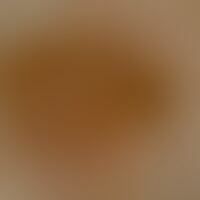Image diagnoses for "brown"
357 results with 1404 images
Results forbrown

Kaposi's sarcoma (overview) C46.-

Lichen planus (overview) L43.-
Lichen striatus: linear lichen "planus" verrucosus arranged in the Blaschko lines.

Neurofibromatosis (overview) Q85.0
Type I Neurofibromatosis, peripheral type or classic cutaneous form. Since puberty slowly increasing formation of these soft, skin-coloured or slightly brownish, painless papules and nodules. Several café-au-lait spots.

Basal cell carcinoma pigmented C44.L

Kaposi's sarcoma (overview) C46.-
Kaposi's sarcoma epidemic (overview): HIV-associated Kaposi's sarcoma with disseminated, bizarrely configured, reddish-brown plaques, sometimes in a striped arrangement.

Demodex folliculitis B88.0
Demodex folliculitis: detailed section with follicular, inflammatory papules.

Contact dermatitis toxic L24.-
contact dermatitis, toxic: overview picture: hyperkeratotic-rhagadiform eczema of the Palma in a 61-year-old, self-employed craftsman. for a long time eczema of the hands and fingers occurred again and again, partly also deep rhagades. occupationally there has been contact with tin-containing analogue paste (tin-containing soldering paste) for a long time. the temporal connection of the first manifestation with the use of the paste is given. on weekends the eczema heals very well, likewise it comes to complete remission during longer work-free intervals (holidays).

Papillomatosis cutis lymphostatica I89.0
Papillomatosis cutis lymphostatica: Large-scale verrucous plaque with a blurred border on all sides, coarsely indurated, with formation of succulent nodules; condition following recurrent erysipelas.

Melanonychia striata L60.8
Melanonychia striata longitudinalis: approx. 0.2 cm wide, dark brown strip of the nail. nail fold very discreetly affected (see inlet). only 1 fingernail is affected. a clinical control (photo documentation) with measurement of the width of the pigment strip is recommended.

Basal cell carcinoma (overview) C44.-
Detailed view: The diagnosis "pigmented basal cell carcinoma" is visible at the left margin, where the spatter-like hyperpigmentation is found (accumulation of melanin clods in the tumor parenchyma, caused by the "accompanying proliferation" of melanocytes). At the upper pole local tumor decay and ulceration.

Basal cell carcinoma (overview) C44.-
basal cell carcinoma superficial. eczema-like aspect. only in the marginal area a smooth shiny seam can be detected when enlarged. this seam is the diagnostic "signal" of the superficial basal cell carcinoma and can be "emphasized" by stretching the surrounding skin.

Neurofibromatosis (overview) Q85.0
Neurofibromatosis segmental, type V Neurofibromatosis. Unilaterally distributed café au lait stains.

Sarcoidosis of the skin D86.3
Sarcoidosis plaque form: 1-year-old, symptom-free, varying in size, symptom-free, surface smooth, brown-reddish, sharply edged plaques.

Verruca vulgaris B07
Verrucae vulgar. exophytic growing wart bed with subungual infiltration at the fingertip.










